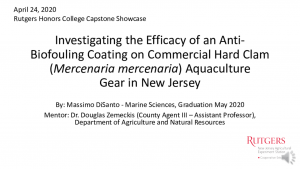DiSanto, Massimo: Investigating the Efficacy of an Anti-Biofouling Coating on Commercial Hard Clam (Mercenaria mercenaria) Aquaculture Gear in New Jersey
Title: Investigating the Efficacy of an Anti-Biofouling Coating on Commercial Hard Clam (Mercenaria mercenaria) Aquaculture Gear in New Jersey
Name: Massimo DiSanto
Major: Marine Sciences
School affiliation: School of Environmental and Biological Sciences
Programs: Honors College Capstone
Other contributors: Douglas Zemeckis, Daphne Munroe, Jenny Paterno Shinn, Jennifer Gius, Jeffrey Silady
Abstract: Biofouling on commercial shellfish aquaculture gear can negatively impact production and increase labor and material costs for farmers. The objective of this study was to evaluate the efficacy of Netminder coating for reducing biofouling on predator-control screens commonly used in commercial hard clam (Mercenaria mercenaria) aquaculture along the east coast of the United States. Fieldwork was completed in collaboration with a commercial shellfish farmer in Great Bay, New Jersey. Six predator control screens (4.3m width x 4.9m length) were deployed in May 2019 with 5,000 clams (mean shell width =29.5±3.6mm) planted under each screen. Three screens were painted with Netminder antifouling coating and three were unpainted. The screens were hauled out in November 2019 and 26-30 clams were randomly collected from each screen to investigate condition and growth. Screens were photographed in 1 m2 quadrats and area covered by biofouling organisms was quantified using image processing software. There was no statistical difference in the average condition (3.367±0.5065 treated, 3.450±0.4893untreated) or average growth rates (30%±18% painted, 33%±16% unpainted) of hard clams collected from painted and unpainted screens. There was considerable variation in the weight and percent coverage of biofouling observed among all screens (weights of dried biofouling ranged from 99.1593 g to 395.6514 g), with the primary biofouling species being Agardh’s red weed (Agardhiella subulata). Overall, biofouling rates were lower than most growing seasons based on industry input. Our preliminary results indicate that the use of Netminder did not affect hard clam condition or growth rates over a seven-month period. Field experiments will be continued to further evaluate the efficacy of Netminder for reducing biofouling, including in years with more typical biofouling rates than observed within the present study.
